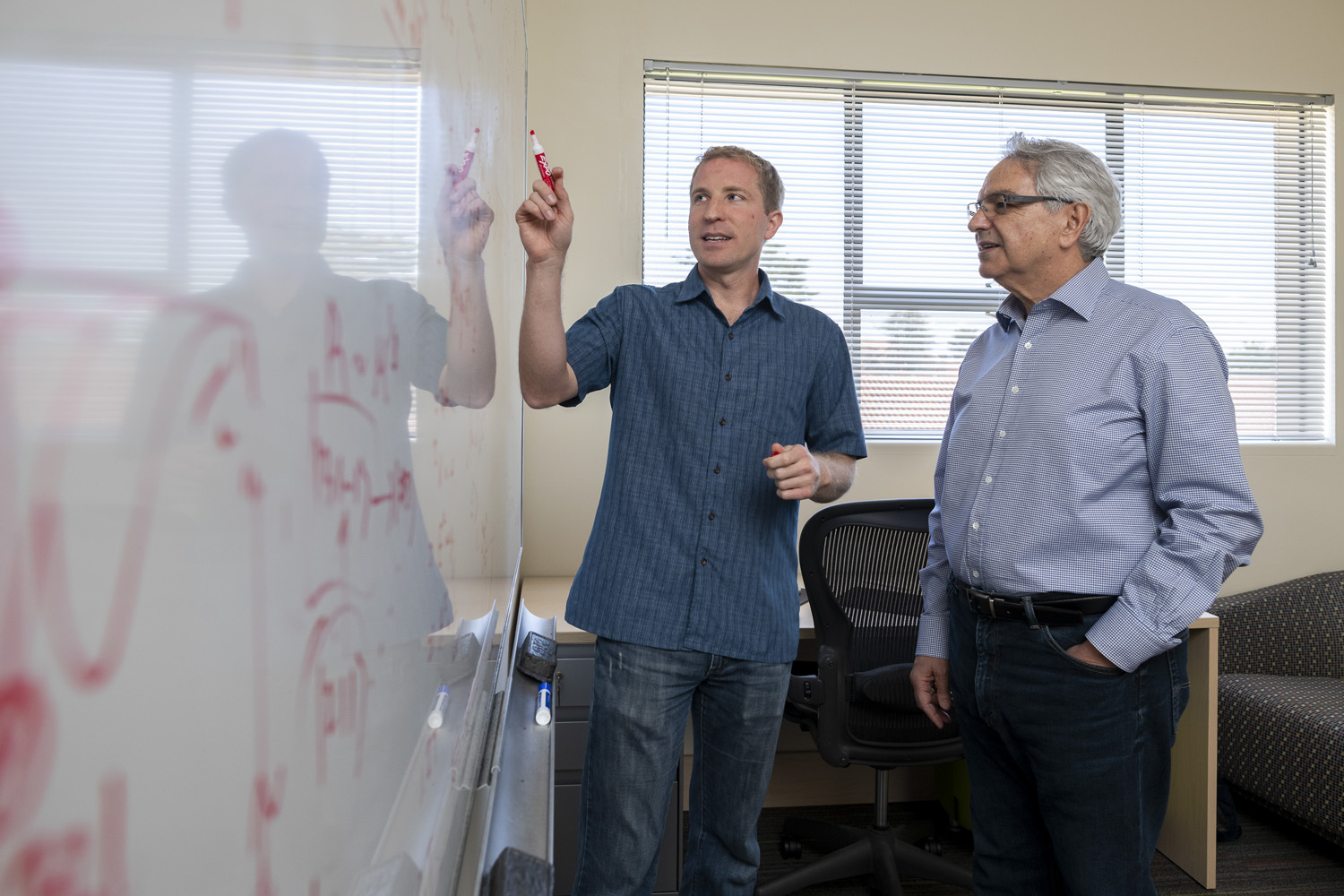Precision physics with ‘tabletop’ experiments

The history of particle accelerators is one of seemingly constant one-upmanship. Ever since the 1920s, the machines – which spur charged particles to near light speeds before crashing them together – have grown ever larger, more complex and more powerful.
Consider: When the 2-mile-long linear accelerator at SLAC National Accelerator Laboratory opened for business in 1966, it could boost electrons to energies of about 19 gigaelectronvolts. The Large Hadron Collider (LHC) at CERN, which finished construction in 2008, can boost protons to more than 700 times higher energy levels and resides in a massive elliptical tunnel wide enough to encircle a small town. Future supercolliders being planned by CERN, China and Japan promise to be even more immense and energetic (and also more expensive).
The strategy has paid off handsomely with discoveries that have helped confirm the soundness of the Standard Model , our current best understanding of how nature’s fundamental forces and subatomic matter interact.
As successful as particle accelerators have been, however, Stanford theorists Savas Dimopoulos and Peter Graham are betting that scientific treasures await discovery in the other direction as well. For years, the pair have argued that smaller and less expensive, but more sensitive, instruments could help answer stubborn mysteries in physics that have resisted the efforts of even the largest atom smashers – questions like “What is dark matter?” and “Do extra spatial dimensions exist?”
“Peter and I and our group have been thinking about this for 15 years,” said Dimopoulos, who is the Hamamoto Family Professor at Stanford’s School of Humanities and Sciences . “We were sort of lonely but very happy because we were exploring new territory all the time and it was a lot of fun. We felt like eternal graduate students.”

Peter Graham and Savas Dimopoulos are among Stanford physicists working on smaller-scale devices to answer large questions. (Image credit: L.A. Cicero)
Scalpel vs. hammer
But their ideas have been slowly gaining traction among physicists, and last fall the Gordon and Betty Moore Foundation awarded Stanford and SLAC researchers three grants totaling roughly $15 million to use quantum technologies to explore new fundamental physics. Key to these efforts are the kinds of small-scale, “tabletop” experiments (so-called because most of them would fit on a lab bench or in a modest-sized room) that Dimopoulos and Graham have long advocated for. “Everything is smaller, except for the ideas,” Dimopoulos quipped. “These types of experiments could help solve some very important problems in physics.”
The instruments Dimopoulos and Graham have in mind exploit the weird properties of quantum mechanics – such as wave-particle duality and the seemingly telepathic link between entangled particles – to detect and measure minute signals and effects that particle accelerators are simply not attuned to.
Tabletop experiments are considered high-risk, high-reward projects because they are generally cheaper to build and operate than colliders, said Asimina Arvanitaki, a theoretical physicist at the Perimeter Institute. “If you’re pitching a project that costs several billion dollars, you better have a very good reason for its existence and be reasonably sure you’re going to succeed,” added Arvanitaki, a former Stanford postdoc in Dimopoulos’ lab. “But the cost of tabletop experiments is so low, and the timescales for producing results is so short, that it takes some of that pressure off.”
Building on existing technologies
The Moore Foundation grants will fund three projects: Two are experimental and will focus on developing new technologies for detecting dark matter and measuring gravitational waves. But the third, worth about $2.5 million and awarded to Dimopoulos and Graham, will be used to further develop the theoretical underpinnings that will enable future experiments.
“There’s been a history of particle accelerators discovering new physics and finding new particles, but it’s not clear that that can go on forever, so it’s important to think of other complementary ways to get at these underlying questions about nature,” said Ernie Glover, the Moore Foundation’s science program officer.
“Everything is smaller, except for the ideas. These types of experiments could help solve some very important problems in physics.”
—Savas Dimopoulos
Professor of Physics
Crucially, the experiments Dimopoulos and Graham are proposing rely on relatively mature, high-precision technologies that, for the most part, were developed with other uses in mind and for other fields, such as medicine and applied physics. “That’s what got us really excited,” Dimopoulos said. “We realized there were all these possibilities out there that particle theorists weren’t really thinking about.”
A good example is nuclear magnetic resonance, or NMR, imaging, which forms the basis of magnetic resonance imaging, or MRI, a common medical scanning technique.
A few years ago, Graham and others theorized that a proposed ultralightweight dark matter candidate called an axion could influence the nuclear spin of normal matter. Dark matter is thought to make up the bulk of the matter in the universe, but it has evaded every attempt so far at characterization. Excited, Graham contacted an atomic physicist at the University of California, Berkeley, named Dmitry Budker to discuss designing a dark matter detector based on this effect – only to discover that the technology already exists.
“He said it’s going to work because what we were describing was basically NMR,” said Graham, a theoretical physicist at the Stanford Institute for Theoretical Physics.
Graham and Budker teamed up with other physicists to design the Cosmic Axion Spin Precession Experiment, or “CASPEr,” which uses NMR (nuclear magnetic resonance) to detect axion and axion-like particles. These particles are predicted to have such weak interactions and low masses that they would never show up in a collider, which are better equipped to search for massive dark matter candidates such as WIMPs (weakly interacting massive particles).
Former Stanford postdoc Asimina Arvanitaki, now at the Perimeter Institute, has proposed several tabletop experiments to investigate physics beyond the reach of particle colliders. (Image credit: Colin Hunter)
Similarly, another Moore Foundation-funded tabletop experiment called MAGIS-100 relies on atom interferometry technology initially developed in the 1990s as a general-purpose tool for making precise measurements. The project, a collaboration between Stanford’s Mark Kasevich and Jason Hogan and researchers at Fermilab and other universities, could potentially detect ripples in spacetime known as gravitational waves around 1 hertz, a frequency range beyond the sensitivity of most existing or even proposed detectors.
Current gravitational wave detectors like LIGO are sensitive to the very final moments of the black hole collisions that generate the spacetime ripples, but MAGIS-100 could provide scientists with a much longer viewing window.
“LIGO saw just a fraction of a second of the event, but the black holes were twirling around each other and generating gravitational waves for millions or billions of years before that. Those waves were just in lower frequency bands,” Graham said. “By looking at other frequencies, we could observe the black holes for longer and perhaps discover new gravitational wave sources.”
Intuition
Dimopoulos and Graham plan to use the Moore Foundation-funding to continue devising new schemes for co-opting technologies like NMR and atom interferometry in the service of fundamental physics research.
“It’s that connection that’s hard,” Graham said. “The experimental physicists and engineers who develop the technologies aren’t necessarily thinking about what other deep, fundamental questions could be tested, and the theorists are often unaware that tools for testing their ideas already exist.”
But Dimopoulos and Graham are now old hands at making such connections. “In principle, you have to know all possible technologies,” Graham said. “In practice, you just have to know the right ones, but it takes a nontrivial intuition to realize something like ‘Oh, wait a minute, it looks like this technique might actually be able to observe extra dimensions or some other new physics.’”
In one sense, what Dimopoulos and Graham are advocating for is a return to the way physics was done before colliders came to play such an important role in physics and the division of physicists into primarily theoretical and experimental camps.
“Before World War II, physics was just like what we’re doing right now,” Dimopoulos said. “Felix Bloch was both a theorist and an experimentalist, and so was Enrico Fermi. Even Einstein did experiments. There wasn’t a ready group of experimentalists that you could outsource your ideas to. You had to invent the techniques and look around at emerging technologies.”
To read all stories about Stanford science, subscribe to the biweekly Stanford Science Digest .
